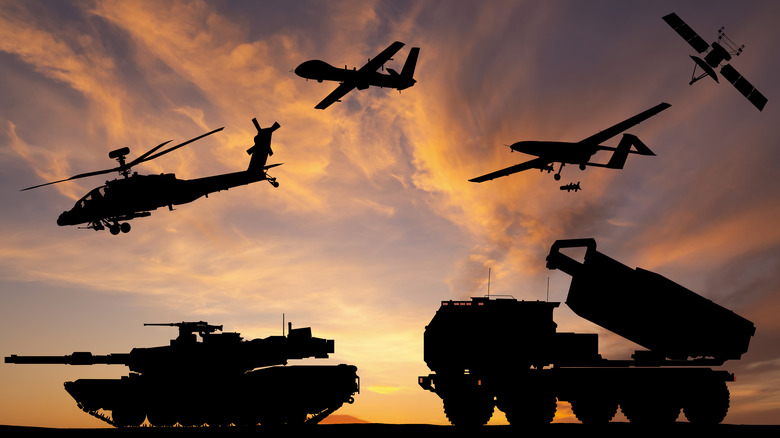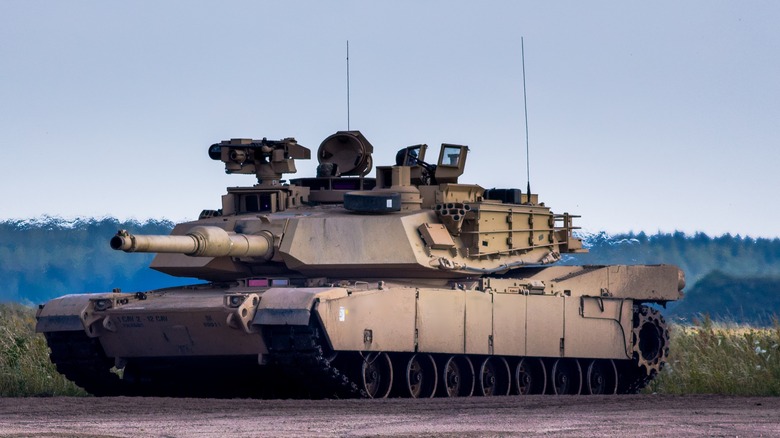How The US Military Plans To Deal With Drones Using Its Tanks
It's hard to overstate just how prolific drones are becoming in modern warfare. In July 2025, Russia used 700 drones in a single night of the war in Ukraine. Drones such as the deadly Shaheds used by Russia and Iran are safer to operate, cheaper to produce, and available in much larger numbers than tanks, and can be very effective against them to boot.
It's essential, then, that a military wielding a lot of ground armor works on both defensive and offensive measures to combat drones, using tanks. The U.S. military, for instance, has devised a plan to shoot them down using 120mm M1028 rounds. Per Task & Purpose, the military's "Tank Platoon" manual was revised in July 2025. The new addition to the document suggests that tank crews observe the flight pattern of a fixed-wing drone, predict its course, then fire approximately "one-half football field in front of [the] nose" ahead to destroy the target (or just above its body in the case of a hovering balloon or incoming quad-style drone). This instruction accompanies a handy diagram of the process.
The issue with drones, however, is that they're often found in great numbers, and they're agile, small targets. It's certainly possible to shoot down a drone in this fashion, as the likes of the Shahed 136 are constructed from cheap, light carbon fiber, but it won't always be practical. For long-term survivability on a battlefield beset by these pesky flying machines, tanks will need other ways to respond. Fortunately for the crew, a range of tactics are available to help minimize this threat.
Other potential anti-drone strategies used by tanks
In warfare, it's inevitable that forces will find themselves on the back foot at times, facing a danger they didn't foresee or a situation they weren't prepared for. In such cases, the key is to be creative and adaptable. Ukraine, then, has wielded the formidable weapon that is the First-Person View drone. This is simply an explosive repurposed by being attached to a small four-rotor drone. Sophisticated, perhaps not, but cheap, portable, and with proven potential to be highly effective.
They're a lurking threat not to be underestimated, and innovative solutions have been sought to help protect tanks from them. The cages on top of Russian tanks are one attempt to mitigate the risk. The U.S., meanwhile, recognizes that a volley of blasts from the guns of tanks isn't the only way to manage that threat, and that sometimes a more defensive approach is called for. The July 2025 Tank Platoon publication also notes the value of "protective construction and overhead cover to provide damage limiting cover for friendly forces and equipment. The hardening and fortifying of cover will limit the threat UAS [Unmanned Aircraft System]'s ability to visually see and limit the damaging effects of an aerial attack."
Tank crews can also call upon the support of a very different type of weapon. Electronic warfare, as wielded by the Russian T-72 tank, for example, can be fatal to some drones, potentially jamming signals and rendering them useless. So while large armored columns can represent a big, valuable target to drone operators, those tanks have important ways of turning the tables.
The future of tanks in the face of drones
We don't know what the future of warfare will look like. Machines, in one fashion or another, are sure to be heavily involved, but drones aren't ready to replace century-proven war machines like tanks just yet. To keep tanks as effective as possible, though, they will have to continue to evolve.
A single tank represents a huge threat on the battlefield in the way that a single small drone doesn't. Deadly as they are, they need to be protected, and there's a simple way to do this: be sure that it has the heaviest armor in the area most likely to be struck. A battlefield dominated by drones means attacks from above, so this is the area that should be reinforced.
In July 2025, retired Army Maj. Michael Liscano Jr. told The War Zone that this was an enormous priority. According to him, no tanks currently boast sufficient top armor to deal with this threat, though the likes of the M1E3 are on the way. "For now," he added, "you will see top turret mounted cope cages, top turret mounted multilayer explosive reactive tiles, and armor plates on top of the turret, and other methods to reduce damage of top attack systems."
The M1E3 is a future solution, and a more sophisticated approach than hoping for a hit with an M1028. The most advanced member of the M1 Abrams tank family, revered as one of the best ever made, they will have a baked-in active protection system, a key weapon in the fight against drones aimed at intercepting and potentially destroying them.


